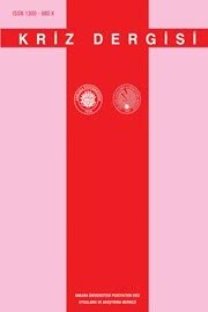BİR HASTALIK OLARAK AŞK: KARŞILIKSIZ AŞK SENDROMU
Neredeyse modern psikiyatri tarihinin başlangıcından beri aşk patolojileriyle ilgilenilmesine rağmen, hemen tüm insanların gündelik yaşamlarında çok önemli olan "aşk", "arzu", "istek" gibi kavramlar ve onların psikopatolojik görünümleri, günümüzün betimleyici psikiyatrisinde yer bulabilmeleri çok zordur. Bugün betimleyici psikiyatride, insanların aşk ilişkilerinde ortaya çıkan psikopatolojik görünümlere, çok basit olarak sanrısal bozuklukların erotomanik alt-tipinde ve ilişki sorunları arasında yer verilmektedir. Bu yazıda, Hegelci felsefenin insan arzusu anlayışından ve ilişki merkezli psikodinamik yaklaşımlardan yararlanarak, betimleyici psikiyatri içinde yeterince ele alınamayan, başkasına yönelik arzunun karşılıksız kalması halinde ortaya çıkan durumları, normalden en patolojik olana doğru bir spektrum içinde ele alma fırsatı veren "karşılıksız aşk sendromu" kavramını ileri süreceğiz. "Karşılıksız aşk sendromu" bir spektrum bozukluğudur. Arzusu umduğu düzeyde karşılık bulmayan, reddedilen ya da reddedildiğini düşünen kişinin spektrumun neresinde yer alacağı, sağlıklı bir kendilik organizasyonu gösterip göstermemesine, nesne ilişkileri bakımından sergilediği performansa ve kullandığı savunma düzeneklerine bağlıdır. Bu makale, yazarın konuyla ilgili literatürü araştırması ve kendi klinik deneyiminin sonuncunda ortaya çıkmıştır.
Anahtar Kelimeler:
Aşk patolojileri, erotomani, karşılıksız aşk.
Love as an illness:Unrequited Love Syndrome.
Although the pathologies of love have been argued since nearly the beginning of the history of modern psychiatry, concepts like "love", "desire", "wish" vvhich are of very importance in daily lives of almost any individual and psychotpathological appearances vvhich these concepts had great difficulty taking up rooms within novvaday's descriptive psychiatry. Today vvithin the descriptive psychiatry the psychotpathological appearances that come out in the love relationships of people are included simply as the erotomaniac type of delusional disorders and relations problems. İn this we argue that the concept of "unrequited love syndrome" can explain the cases in vvhich desire directed towards others has been unrequited vvithin a spectrum ranging from the normal to the most pathological and this can be realized not by being engaged in the descriptive psychiatry but by benefiting from the Hegelian understanding of human desire and the opportunities offered by the relation-centered psychodynamic appoaches. VVhere to place in the spectrum the person whose desire s/he thinks has not been requited at the expected level or who has been rejected or who thinks has been rejected depends on vvhether s/he displays a healthy self-organization, on the development performance s/he exhibitis in respect of object relations and on the defence mechanisms s/he applies. This revievv is based on the author's knovvledge of reports in the joumals and books, supplemented by medline searches to update particular subtopics and his clinical experience.
Keywords:
Love pathologies, erotomani, unrequited love.,
___
- Boast N, Coid J (1994) Nomosexual erotomania and HIV infection. Br J Psychiatry, 164:842-846.
- Cashdan S (1988) Object Relations Therapy. New York, W.W. Norton & Company.
- Dunlop JL (1988) Erotomania betvveen women. Br J Psychiaty, 153:830-833.
- Ellis P, Mellshop G (1985) De Clerambault Syndrome a nosological entity? Br J Psychiatry, 146:90-93.
- Evans DL, Jeckel LL, Slott NE (1982) Erotomania, a variant of pathological mourning. Bull Menninger Clin, 46:507-520.
- Hallender MH, Callahan AS (1975) Erotomania or De Clerambault syndrome. Arch Gen Psychiaty, 32:1574- 1576.
- Jordan HW, Howe G (1980) De Clerambault Syndrome (erotomania): a revievv and case presentation. J Natt Med assoc, 72:979-998.
- Kernberg OF (1995) Love Relations: normality and Pathology. New Haven-London, Yale University Press. Kojeve A (1988) Köle-efendi diyalektiği. Çev. Bumin T. Defter, 6:7-29.
- Lacan J (1981) The Four Fundamental Concepts of Psycho-analysis. Çev. Sheridan A. New York-London, W.W. Norton & Company.
- Madun S (1995) Postyapısalcılık ve Postmodernizm. Çev. Güçlü AB. Ankara, Ark Yayınları, s. 7-31.
- Meloy R (1989) Unrecuited love and the wish to kili: diagnosis and treatment of boderline erotomania. Bull Menninger Clin, 53:477-492.
- Meloy R, Gothard S (1995) Demographic and clinical comparison of obsessional follovvers and offenders with mental disorders. Am J. Psychiatry, 152:258-263.
- Mullen PE, Pathe M (1994) The pathological extensions of love. Br J Psychiatry,. 165:614-623.
- Pearl A (1972) De Clerambault Syndrome associated with folie a deux. Br J Psychiatry, 121:116-117.
- Perez C (1993) Stalking: when does obsession become a erime? Am J Psychiatry Crim L, 20:263-279.
- Raskin DE, Sullivan KE (1974) Erotomania. Am J Psychiatry, 131:1033-1035.
- Rudden M, Gilmore M, Frances A (1980) Erotomania: a separate entity. Am J Psychiatry, 137:1262-1263.
- Rudden M, Sweeney, J Frances A (1990) Diagnosis and clinical course of erotomanic and other delusional patients. Am j Psychiatry, 147:625-628.
- Seeman M (1978) Delusional loving. Arch Gen Psychiatry, 34:1265-1267.
- Segal JH (1993) Erotomania revisited: From Kraepelin to DSM-III-R. Am J Psychiatry, 146:1261-1266.
- Stien MB (1986) Two cases of "püre" or "primary" erotomania successfully treated with pimozide (letter). Can J Psychiatry, 31:289-290.
- Taylor P, Mahedra B, Gunn J (1983) Erotomania in males. Psychol Med, 13:645-650.
- Zona M. Sharma K, Lane J (1993) A comparative study of erotomanhic and obsessional subjects in forensic sample. J. Forensic Sci, 38:994-903.
- ISSN: 1300-980X
- Başlangıç: 1992
- Yayıncı: Ankara Üniversitesi
